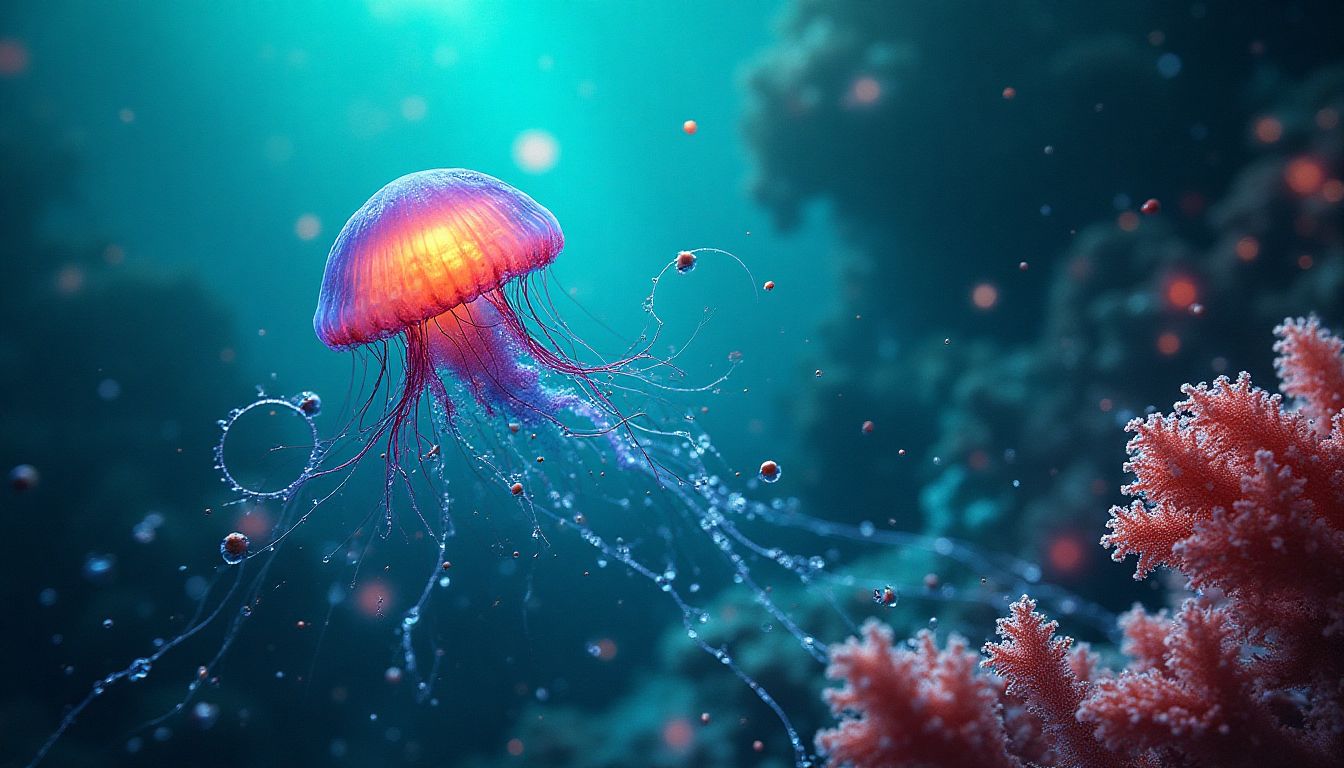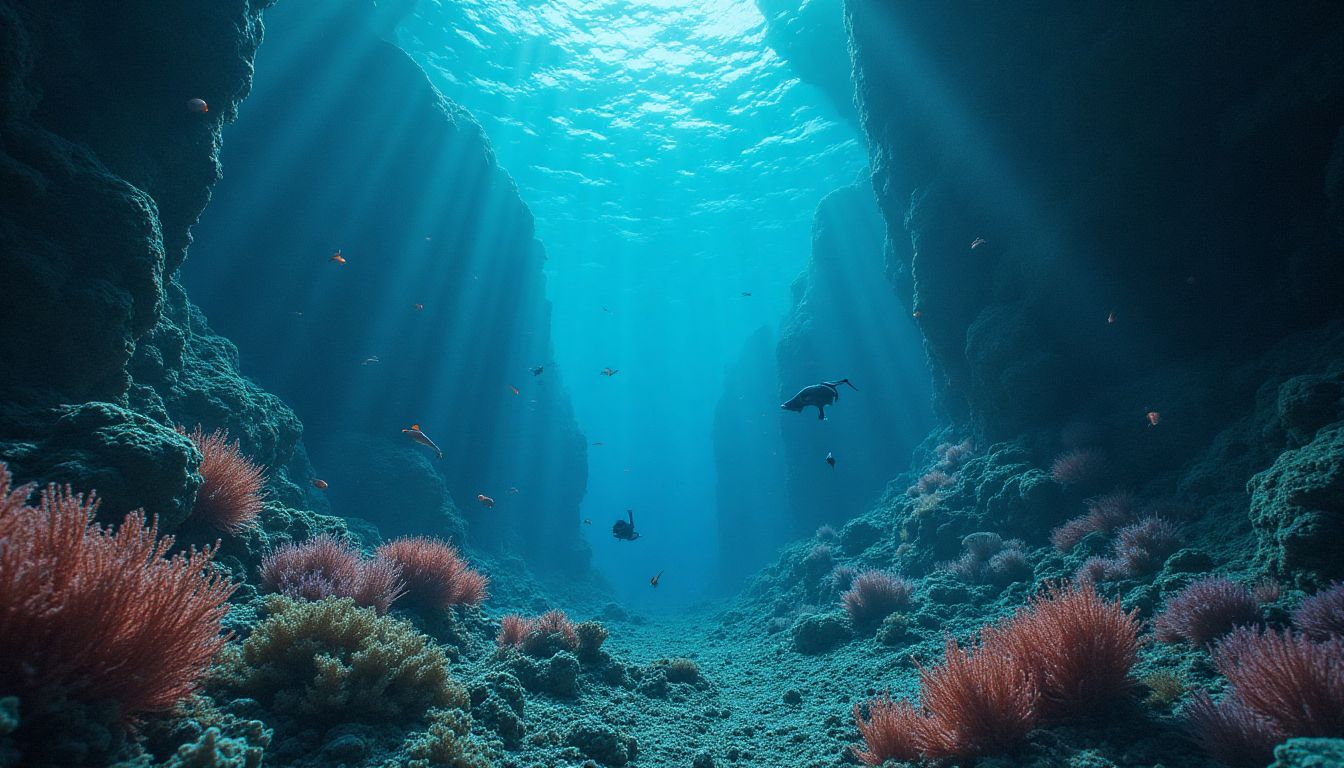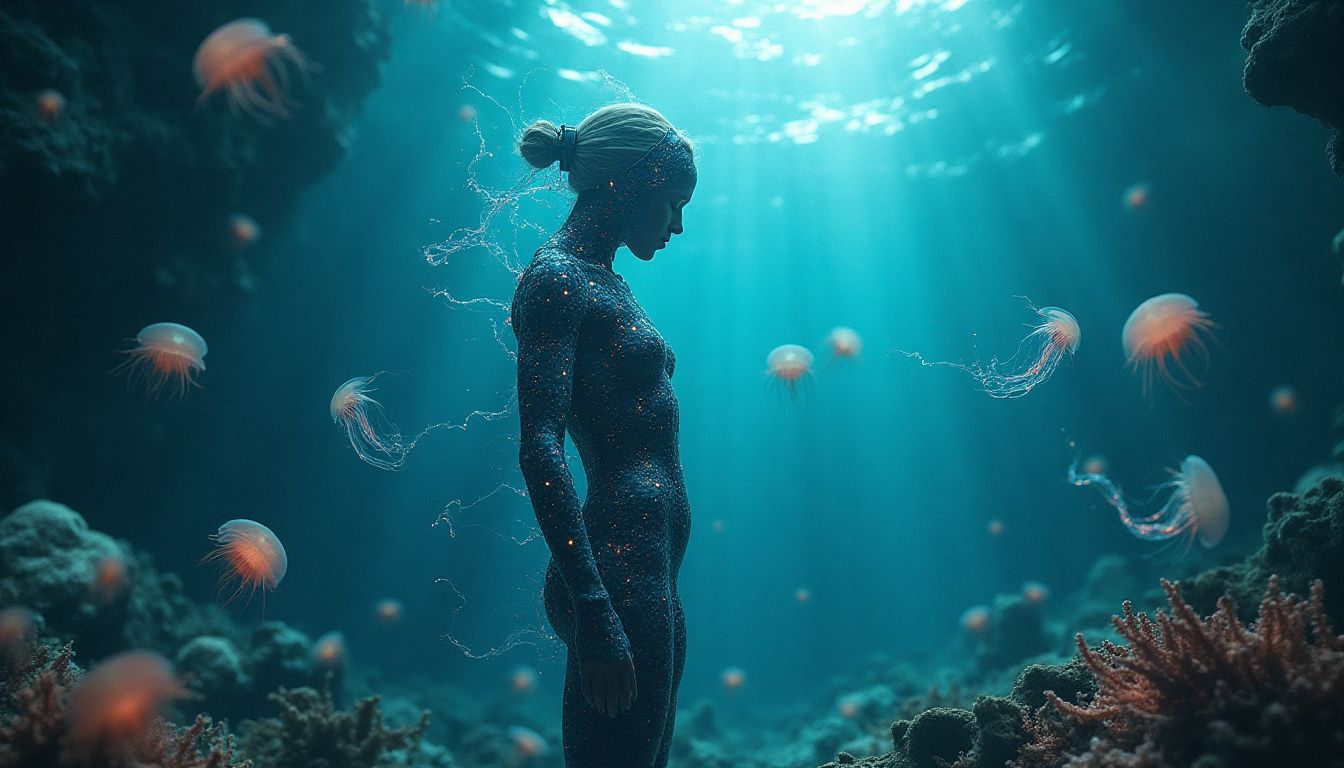Introduction: The Final Frontier Beneath the Waves
In the depth of winter, I finally learned that within me there lay an invincible summer. – Albert Camus. Camus spoke of resilience, and what better metaphor is there for the pressures of the deep sea? Like winter's chill, the ocean's depths are unyielding and forbidding, yet offer endless mysteries waiting to be uncovered. Could the answer lie within us, waiting to be unlocked? Picture a world where human beings, modified at the genetic level, can thrive in the ocean's deepest trenches. Could we embrace these extreme environments as naturally as penguins take to the frigid Arctic waters?
As necessities and curiosities push humanity further into the vast unknown, the emerging field of genetic engineering affords us the chance to redefine our relationship with the sea. Luminaries like Craig Venter, George Church, and Stephen Quake have long explored the depths of genetic possibilities. Integrating such innovations with marine biology could lead to unfathomable breakthroughs. Through this article, we plunge into the science of modifying humans to endure extreme ocean pressures, unveiling the dreams, perils, and mysteries hidden beneath the sea.
The Science of Life Under Pressure
The deep sea, one of Earth's last unexplored frontiers, challenges life as we know it. Consider this: at the bottom of the Mariana Trench, the pressure is more than 1,000 times what we experience at sea level. Yet some extraordinary creatures thrive there. How do they do it? The secrets lie in their DNA, and they might hold the keys to human adaptation.
The Role of Extremophiles
Deep-sea giants like squids and anglerfish exhibit captivating adaptations. Imagine having skin more flexible than a gymnast’s or proteins more specialized than a world-class chef's knife. These extremophiles have evolved over millennia to survive under crushing depths. By studying them, scientists such as Sylvia Earle are unlocking the genetic secrets of pressure resilience.
Genetic Modifications: Techniques and Technologies
Enter CRISPR-Cas9 – the genetic toolkit that's revolutionizing the world. Instead of playing with Legos, scientists now play with genes. CRISPR allows precise genetic changes, like editing a document but far more consequential. By identifying and inserting genes responsible for pressure resistance, researchers envision a future where humans can explore the deep sea with ease, perhaps turning mermaiding from fantasy into reality.
The Ethical Landscape of Genetic Engineering
It's like preparing a sandwich with the best organic bread, only to realize you're unsure if the filling is legitimate. The notion of bioengineering our own species carries profound ethical concerns, much like being handed a pen without a manual for doodling on the fabric of life itself. Let's dive into these ethical conundrums.
Ethical Considerations in Genetic Modification
At the heart of the debate is identity. Are we stepping onto a slippery slope of redefining who we are? According to CRISPR pioneers, the potential of genetic modification stirs the waters of acceptance—or resistance—within society. Consent, another hefty buoy, raises the question: who gets to decide on these changes, especially when a human thumb isn't involved in the process?
Regulating Genetic Engineering: A Global Approach
Creating a cohesive regulatory framework is the lifebuoy we grasp to navigate these ethical seas. International collaboration is paramount because, while some countries might welcome bioengineering like a warm sunshine, others might find it as comforting as a cold seawater bath. Organizations like the World Health Organization are essential for aligning international policies and practices.
Potential Health and Societal Impacts
Diving into the deeper seas of this debate, we uncover that the ripple effect of genetic modifications spreads to health and society at large, like a pebble disrupts the surface of a still pond, with potential benefits and challenges intertwined like seaweed in a strong ocean current.
Enhancing Human Physiology for Extreme Environments
The Holy Grail of adapting humans for underwater life may very well revolutionize medicine. Imagine breakthroughs in tackling conditions linked to pressure and low oxygen. Universities like the Stanford School of Medicine investigate alternative treatment approaches, inspired by our underwater ambitions.
Societal Implications: New Careers and Economy
Picture a world with underwater architects or deep-sea resource managers—trendy career paths that emerge in this oceanic economy. This evolutionary leap in human capability promises to spark an economic boom, with industries akin to those seen in sci-fi movies. Rethink your career daydreams; the next job fair could include scuba equipment and sonar tests!
4. Biotechnological Innovations Driving Research
The deep-sea exploration frontier is primarily powered by groundbreaking technological advancements. Biotechnology, in particular, has propelled us into a new era of immense research possibilities. The convergence of disciplines has allowed for gains in our understanding of marine ecosystems while opening doors to pioneering innovations.
4.1 Collaborative Ventures: Academia and Industry
When it comes to pushing the boundaries of marine genetic engineering, partnerships between academia and industry play a pivotal role. Institutions like MIT and tech companies such as Ocean Infinity lead the charge in this exciting venture, driving collaborative research that results in technological marvels capable of thriving under treacherous conditions.
Here are some prominent benefits of these partnerships:
- Resource Sharing: Access to state-of-the-art technology and funding from the industry.
- Academic Expertise: Insights from leading experts in genetic engineering and marine biology.
- Innovation Acceleration: Faster progress through collaborative efforts and shared goals.
4.2 Advanced Biotechnology Applications
As new biotechnologies emerge, they become essential instruments in analyzing genetic data and designing organisms that can thrive in extreme environments. Innovations like synthetic biology, and bioinformatics are at the forefront of this revolution, enabling us to manipulate biological systems for unprecedented adaptation.
Consider the following advancements:
- Synthetic Biology: The design of new biological parts, devices, and systems for oceanic adaptation.
- Bioinformatics: Harnessing computational tools to manage and interpret vast quantities of genetic data.
- Genome Editing: Technologies like CRISPR pave the way for precise DNA modifications.
These applications highlight the imaginative possibilities of biotechnology in marine adaptation. By leveraging these advancements, it becomes possible to envision a future where humans can, and indeed do, thrive in the unforgiving depths of the ocean.
5. Human Adaptation Strategies: The Path Forward
For humans to adapt to the extraordinary pressures of life underwater, we need a well-crafted strategy that combines genetic engineering with behavioral and technological adaptations. This multifaceted approach ensures a robust path to achieving underwater resilience.
5.1 Enhancing Human Design: Merging Biology and Technology
Picture a future where beings of flesh and circuit coexist—a harmonious blend of biology and technology. This imagery isn't just the stuff of science fiction novels. By melding biomechanical enhancements with genetic modifications, we can create super-adapted humans suited for deep-sea life.
Potential enhancements include:
- Biological Modifications: Genetic tweaks to improve cellular elasticity and pressure tolerance.
- Biomechanical augmentations: External elements tailored to augment strength and resistance against high-pressure environments.
These enhancements not only pave new paths for human existence, but they also lay the groundwork for how we perceive our integration with marine habitats.
5.2 Adaptation Phases: From Research to Realization
Turning aspiring adaptations into a vibrant reality involves rigorous strategizing, dedicated research, and methodical execution. The road to success features varied phases:
| Phase | Description |
|---|---|
| Initial Research | Identify key genetic markers from extremophiles. |
| Animal Models | Perform tests to evaluate success and safety in other species. |
| Human Trials | Launch trials with rigorous ethical evaluations and monitoring. |
This progression, from concept to concrete realization, epitomizes the diligent approach we must adopt to secure our future beneath the waves—a future where adaptation morphs into a spectrum of opportunities rather than mere survival.
AI Solutions: How Would AI Tackle This Issue?
Artificial Intelligence (AI) isn't just the glorious frontier of technological development; it's also a powerful ally in our quest to modify humans for deep-sea exploration. With its incredible data processing capabilities and knack for spotting patterns, AI can significantly speed up research and innovation in genetic engineering. The integration of AI in this field ushers in a new era of possibilities.
Data Mining and Analysis
Imagine AI algorithms diving into oceans of genetic data gathered from extremophiles, sorting through it faster than the best human researchers could. By identifying key genes associated with pressure resistance and similar adaptations, AI presents researchers with an invaluable roadmap. It’s like having a trusty guide on our journey through the treacherous terrains of marine genetics. These advanced models don’t just streamline the information processing; they enhance the quality of insights, allowing for focused research efforts and greater success rates.
Simulating Outcomes and Predictive Modeling
The true magic of AI lies in its ability to simulate genetic modifications and predict outcomes before actual trials begin. This predictive modeling can eliminate a lot of guesswork, substantially reducing the iterative trial-and-error phase that often bogs down scientific research. By employing machine learning techniques, scientists can predict how specific genetic adjustments will function under high-pressure environments, making the journey to human adaptation more efficient and less risky. With AI, we can paint a vivid picture of our human potential beneath the waves and refine our strategies based on simulated outcomes.
Actions Schedule/Roadmap (Day 1 to Year 2)
Day 1: Assemble a Diverse Team
Bring together geneticists, marine biologists, ethicists, AI experts, and technology innovators from leading research institutions such as MIT and Stanford University. Define goals, roles, and responsibilities for each domain. Cross-disciplinary collaboration is essential to unlock new ideas.
Day 2: AI Induction Workshop
Conduct a workshop to introduce AI tools to geneticists and marine biologists. Familiarization with platforms such as IBM Watson can bridge traditional biology with cutting-edge machine learning techniques.
Week 1: Comprehensive Literature Review
Conduct an exhaustive literature review on extremophile genetics, existing adaptations, and the current state of AI in biogenetics. The team must grasp foundational knowledge to inform strategic planning.
Weeks 2-3: Data Collection Expedition
Embark on oceanographic expeditions with partners such as Ocean Infinity. Collect DNA samples from extremophiles living in high-pressure environments: hydrothermal vents, deep-sea trenches, and abyssal plains.
Week 4: AI Model Development
Leverage AI to analyze genetic and environmental data from the sampling expeditions. Develop predictive models that allow the team to simulate various gene alterations and their physiological impacts.
Month 2: Ethical Framework Development
Assemble an ethics committee to draft guidelines for genetic modifications. Seek international collaboration, inviting representatives from organizations like the World Health Organization and the United Nations to ensure a comprehensive perspective on ethical considerations.
Month 3: Public Outreach Initiative
Launch a public engagement campaign to foster community involvement and transparency. Host informational webinars, Q&As, and local forums to discuss the implications and potential of genetic adaptation for deep-sea exploration.
Year 1: Trials and Testing Phase
Begin controlled studies on modified animal models after preliminary lab success. Monitor genetic alterations and physiological changes under simulated high-pressure conditions, continuously refining AI predictive models based on observations.
Year 1.5: International Symposium on Marine Biotechnology
Host a global symposium to showcase research findings and ethical discussions. Engage scientists, policymakers, ethicists, and the public to discuss the trajectory of human adaptations for deep-sea exploration.
Year 2: Initiate Human Trials
Based on the success of animal trials, seek regulatory approval for voluntary human trials. This includes thorough face-to-face conversations with potential subjects about risks and benefits, focusing on informed consent regarding experimental modifications.
Conclusion: The Future Awaits Beneath the Waves
As we plunge into the depths of the oceanic abyss, our journey toward genetic engineering for deep-sea exploration may redefine the bounds of human capabilities. The idea of altering our genetic makeup to withstand the pressures of the deep is audacious, yet the potential rewards are even greater. We could unlock the secrets of the ocean's past and future, unveiling vast resources and new ecosystems while deepening our understanding of our world's mysteries. However, this endeavor invites immense responsibility and ethical contemplation. As we embark on this exciting path, it's vital to engage in thoughtful discussions and collaborations, ensuring that we proceed with care and respect for the unknown. The horizon of human adaptation is just beginning to shimmer in the sunlight above the waves. Are we prepared to take the plunge? What lies beneath may challenge our very understanding of existence, and each decision made along the way will echo into eternity.
FAQ
Q: What is genetic engineering?
A: Genetic engineering is the process of changing the DNA in an organism. This helps scientists create new traits or enhance existing ones. For example, they might make crops grow better or make animals resistant to diseases. You can learn more about genetic engineering from the Nature Education website.
Q: Can humans really adapt to extreme underwater pressures?
A: With our scientific advancements, especially in genetic engineering, it is possible for humans to adapt to pressure underwater. Researchers study animals like deep-sea fish and extremophiles for clues. These creatures survive in harsh conditions, and scientists hope to mimic their adaptations for humans.
Q: What are extremophiles?
A: Extremophiles are special creatures that live in extreme environments, like deep oceans or hot springs. They thrive where most other life cannot. Some examples include:
- Thermophiles – love heat, found in hot areas.
- Halophiles – thrive in salty environments.
- Acidophiles – enjoy acidic surroundings.
Scientists study these organisms to find ways to help humans survive in extreme conditions, like deep-sea exploration.
Q: What ethical concerns are there with genetic modifications?
A: There are several important questions that arise when we talk about changing human DNA. Some of these concerns include:
- Consent: Would individuals fully understand the changes that are being made to their bodies?
- Identity: How would these changes affect what it means to be human?
- Unforeseen consequences: What could go wrong with the modifications?
It's important for society to discuss these issues and decide how to responsibly approach genetic engineering.
Q: How can AI help with genetic research for deep-sea exploration?
A: Artificial Intelligence (AI) can make things faster and easier for scientists. It can:
- Analyze lots of genetic data to spot important patterns.
- Simulate changes before they happen to see what might occur.
- Help researchers make informed decisions about genetic modifications.
By using AI, scientists can explore genetic engineering options much more efficiently. For more details on AI in biotech, visit MIT Technology Review.
Q: What is the timeline for developing pressure-adapted humans?
A: The process consists of several stages, which could look like this:
- Research and Planning: One year to gather information and form teams.
- Testing: About 6 to 12 months testing with animal models before progressing to humans.
- Human Trials: This could start from 1.5 years to 2 years, depending on earlier results.
The timeline is flexible and could change based on discoveries made along the way. It's important to take time for thorough research.
Q: What new careers might arise from deep-sea exploration?
A: As we develop technology for deep-sea exploration, new job opportunities might emerge, such as:
- Marine geneticists who study underwater life and genetic adaptations.
- Deep-sea engineers who design vehicles and equipment for underwater exploration.
- Ethicists specializing in the moral aspects of genetic engineering.
Each of these roles plays a vital part in the future of exploring and understanding our oceans.
Q: What further research is being done in this field?
A: Many universities and organizations are actively researching deep-sea genetics and adaptations. Institutions like Stanford University and MIT are at the forefront of this research. You can find exciting advancements and projects on their websites.
Q: How can I learn more about ocean exploration?
A: To dive deeper into ocean exploration, consider checking out resources like:
These sites offer valuable insights into the wonders and mysteries waiting beneath the waves.
Wait! There's more...check out our gripping short story that continues the journey: The Storm
Disclaimer: This article may contain affiliate links. If you click on these links and make a purchase, we may receive a commission at no additional cost to you. Our recommendations and reviews are always independent and objective, aiming to provide you with the best information and resources.
Get Exclusive Stories, Photos, Art & Offers - Subscribe Today!





























Post Comment
You must be logged in to post a comment.